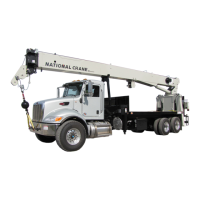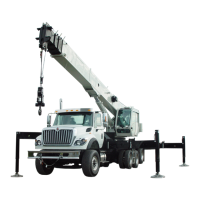National Crane Published 5-27-2018 Control # 039-06 3-5
800D MAINTENANCE
Wire rope shall be taken out of service when any of the
following conditions exist:
• In rotation resistant ropes: two randomly distributed
broken wires in six rope diameters or four randomly
distributed broken wires in 30 rope diameters.
• Severe corrosion as evidenced by pitting
• Necking down of the rope indicates core failure.
• Kinking, crushing, bird caging, or any other damage
resulting in distortion of the rope structure.
• Evidence of heat damage.
• Reductions from nominal diameter of more than 5%.
• One outer wire broken at its point of contact with the core
of the rope which has worked its way out of, and
protrudes or loops out from the rope structure.
• In running ropes, six randomly distributed broken wires
in one lay or three broken wires in one strand in one lay.
• National Crane recommends that for cable extended
booms, a single damaged wire rope assembly shall
require replacement of the entire set of extension
cables.
• National Crane recommends that boom extension
cables be replaced every seven (7) years.
Adjustments and Repairs
Before adjustments and repairs are started on a crane, the
following precautions shall be taken as applicable:
1. A warning tag should be placed in a conspicuous
place at the controls stating that the machine
requires adjustment or repair before it can be
operated.
2. The crane should be placed where it will cause the
least interference with other equipment or
operations in the area.
3. All controls at the OFF position and all operating
features secured from inadvertent motion by brakes
or other means.
4. All methods used to start the truck’s engine
rendered inoperative.
5. Power plant stopped or disconnected at take off.
6. Boom lowered to the ground or otherwise secured
against dropping.
7. Load block lowered to ground or otherwise secured
against dropping.
8. Relieve hydraulic oil pressure from all hydraulic
circuits before loosening or removing hydraulic
components.
After adjustments and repairs have been made, the crane
shall not be returned to service until all guards have been
reinstalled, trapped air removed from hydraulic system if
required, safety devices reactivated, and maintenance
equipment and all warning tags removed.
Any hazardous conditions disclosed by the inspection
requirements listed above shall be corrected before
operation of the crane is resumed. Adjustments and repairs
shall be done only by designated personnel who are properly
trained. Use only National Crane supplied parts to repair the
crane.
Seizing Wire Rope
It is important to seize the ends of rotation resistant wire
ropes to prevent the displacement and unraveling of the
individual wires and strands at the ends. All preformed and
non-preformed styles of wire rope should be seized prior to
cutting. Seizings must be placed on both sides of the point
where the wire rope is to be cut.
The two preferred methods for seizing wire ropes are:
Method 1
Using a length of soft annealed wire Figure 3-2, place one
end in the groove between two strands of the wire rope. Turn
the long end of the annealed wire at right angles to the wire
and wrap it tightly over the portion in the groove.
The two ends of the annealed wire should be twisted
together tightly. Cut off the excess wire and pound the twist
flat against the wire rope.
Fo
r
Reference
Only
